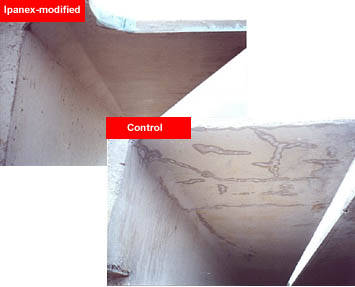

|
Technical Info
IPANEX DATA SHEET (pdf) MSDS SHEET (pdf) IPANEX for Waterproof Concrete When the two principal components of portland cement - tricalcium silicate and dicalcium silicate - react with water, they form a complex calcium silicate hydrate compound called C-S-H. This compound is effectively the "glue" in portland cement. As C-S-H forms and grows in hydrating concrete, a network of pores forms among the hydrating cement particles - even with the C-S-H itself. Large pores and uncomplicated network channels allow water to easily enter and leave the concrete, often penetrating deep into the structure to cause corrosion. If the interconnected pores are smaller and have a very sinuous path-way, however, water can only penetrate a short distance into the structure. This property is referred to as tortuosity. Ipanex controls the way hydrating concrete forms - uniformly redistributing the C-S-H already being formed within the concrete to produce a more homogeneous, fine-grained microstructure. The nucleation process that occurs when Ipanex is added to portland cement concrete not only reduces the size of the pores, it also makes the path that water has to follow more difficult. This increased tortuosity minimizes water's ability to penetrate to the interior of concrete structures. Other concrete admixtures contain organic chemicals or mineral by-products that change the chemical and physical properties of the concrete without altering the chemical composition. The only thing Ipanex adds is more C-S-H, identical to the hydration products already in portland cement. |
||||
 |
These two Double T's were cast at the same time at the same pre-cast facility. Mixing, placement, curing and storage were identical for each. | |||
|
home |
profiles |
tech info |
articles/studies |
cias report |
faq |
news |
contact us phone:215-425-6607 toll free:800-523-3834 email:info@ipasystems.com Copyright © 2016 Cement Chemistry Systems, LP |
||||